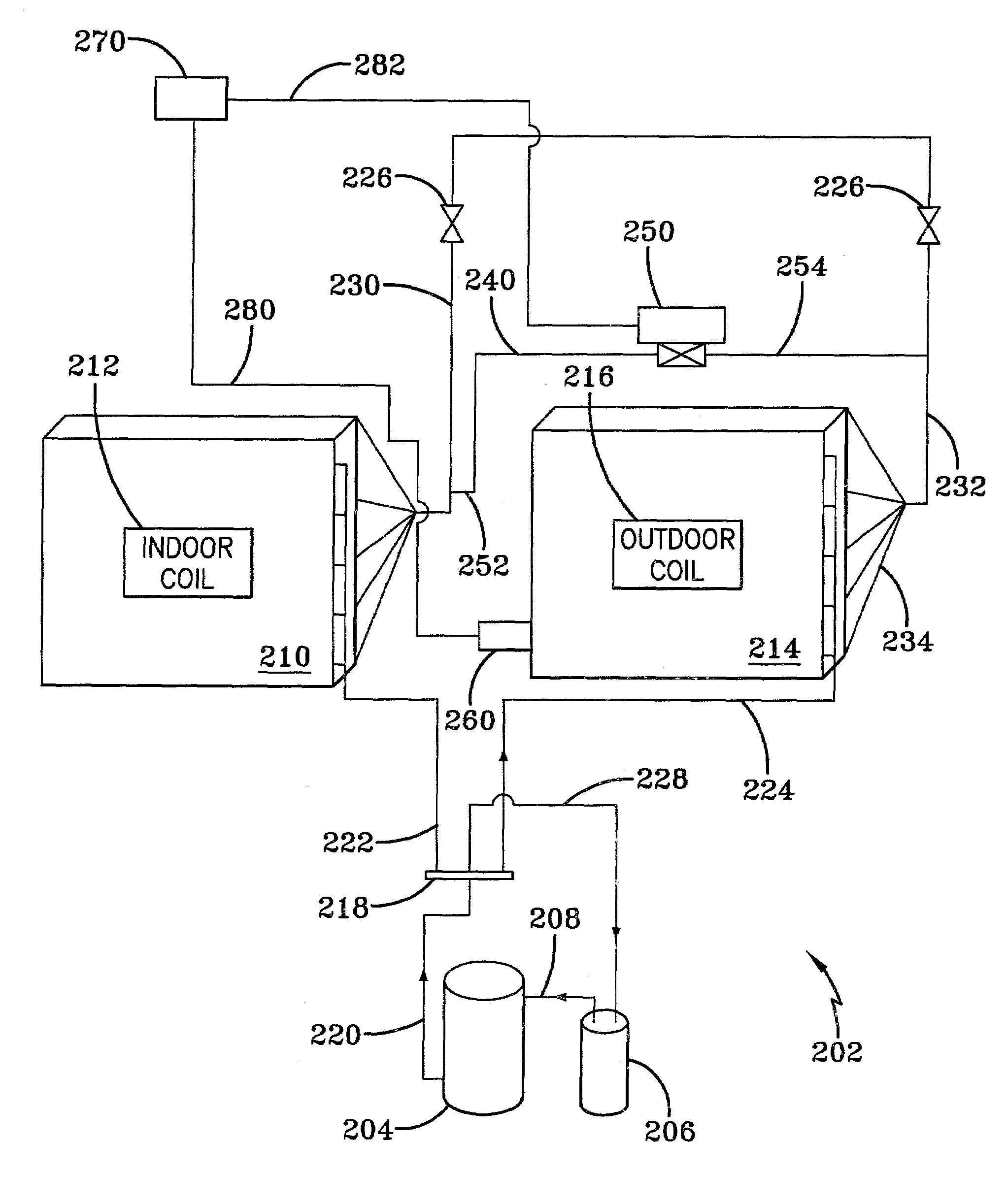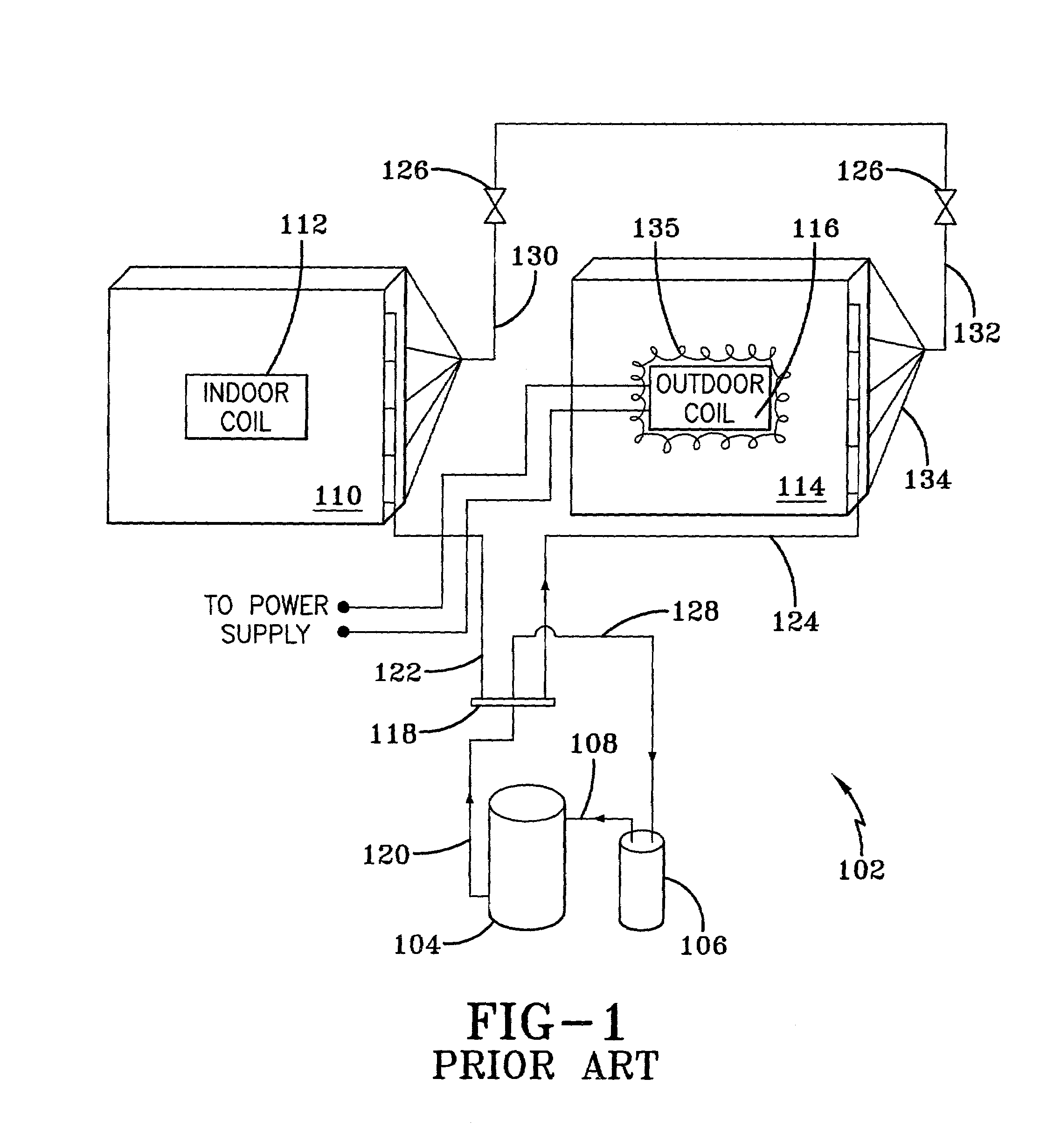Air-to-air heat pump defrost bypass loop
- Summary
- Abstract
- Description
- Claims
- Application Information
AI Technical Summary
Benefits of technology
Problems solved by technology
Method used
Image
Examples
example 1
[0027]An air-to-air heat pump system 302, shown in the heating mode, includes a defrost bypass loop 340 as depicted in FIG. 3. A defrost bypass loop 340 connects a refrigerant discharge means, such as a discharge line 330, from the indoor coil unit 310 to the inlet line 332 of the outdoor unit. A bypass line having a first end 352 and a second end 354 connects to discharge line 330 at its first end 352 between indoor coil unit 310 and expansion device 326. A valve 350 is located in bypass line. Bypass line 352, 354 connects to inlet line 332 at its second end 354.
[0028]A temperature sensing device 360 is placed in contact with outdoor coil 316 to periodically or continuously monitor the actual temperature of outdoor coil 316. Temperature sensing device 360 can be any well known temperature monitoring device such as a thermocouple, thermistor and the like. Temperature sensing device 360 is in communication with controller 370 along path 380. Communications path 380 may be any conveni...
example 2
[0031]Referring now to FIG. 4, a slight variation to the previousiy described defrost bypass loop 340 is set forth. This variation results in a different operation of the defrost bypass loop 440. Air-to-air heat pump system 402 is similar to heat pump system shown in FIG. 2. However, in this configuration, temperature sensor 460 is located within outdoor unit 414 to monitor the ambient temperature within outdoor unit 414, but not attached to outdoor coil 416. Alternatively, temperature sensor 460 may be located external to outdoor unit 414 to monitor the ambient temperature. When temperature measuring device 460, transmits a signal to controller 470 indicating that the temperature within outdoor unit 414, or alternatively the outdoor ambient temperature, corresponds to a predetermined set point, controller 470 activates a timing means, such as a timer, for use in a timed sequence operation, which may be preprogrammed into a programmable controller, causing heat pump unit 402 to redu...
example 3
[0032]Referring now to FIG. 5, a different embodiment of the present invention. a slight variation to the previously described defrost bypass loops X40, where X40 represents any of the previously discussed loops, is set forth. This variation results in a different operation of the defrost bypass loop 540. Air-to-air heat pump system 502 is similar to heat pump system shown in FIG. 2. However, in this configuration, a sensor 560 is located either within outdoor coil 516 or within line 524 leaving the evaporator 514, as shown in FIG. 5, or within outdoor coil itself. Sensor 560 monitors a condition of the refrigerant. It can be set to monitor, for example the temperature of the refrigerant or the pressure of the refrigerant gas. For a refrigerant, the temperature at which a phase change from liquid to gas is known. If the temperature of the refrigerant is too low, insufficient refrigerant is undergoing a phase transformation from liquid to gas and the refrigerant gas pressure is also ...
PUM
 Login to View More
Login to View More Abstract
Description
Claims
Application Information
 Login to View More
Login to View More - R&D
- Intellectual Property
- Life Sciences
- Materials
- Tech Scout
- Unparalleled Data Quality
- Higher Quality Content
- 60% Fewer Hallucinations
Browse by: Latest US Patents, China's latest patents, Technical Efficacy Thesaurus, Application Domain, Technology Topic, Popular Technical Reports.
© 2025 PatSnap. All rights reserved.Legal|Privacy policy|Modern Slavery Act Transparency Statement|Sitemap|About US| Contact US: help@patsnap.com



